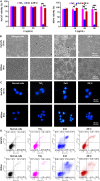Zinc-metal-organic frameworks with tunable UV diffuse-reflectance as sunscreens
- PMID: 35183191
- PMCID: PMC8858458
- DOI: 10.1186/s12951-022-01292-1
Zinc-metal-organic frameworks with tunable UV diffuse-reflectance as sunscreens
Abstract
Background: UV exposure continues to induce many health issues, though commercial sunscreens are available. Novel UV filters with high safety and efficacy are urgently needed. Metal-organic frameworks (MOFs) could be a suitable platform for UV filter development, due to their tunable optical, electrical, and photoelectric properties by precise controlled synthesis.
Results: Herein, four zinc-based MOFs with various bandgap energies were chose to investigate their optical behaviors and evaluate their possibility as sunscreens. Zeolitic imidazolate framework-8 (ZIF-8) was found to possess the highest and widest UV reflectance, thereby protecting against sunburn and DNA damage on mouse skin and even achieving a comparable or higher anti-UV efficacy relative to the commercially available UV filters, TiO2 or ZnO, on pig skin, a model that correlates well with human skin. Also, ZIF-8 exerted appealing characteristics for topical skin use with low radical production, low skin penetration, low toxicity, high transparency, and high stability.
Conclusion: These results confirmed ZIF-8 could potentially be a safe and effective sunscreen surrogate for human, and MOFs could be a novel source to develop more effective and safe UV filters.
Keywords: Diffuse-reflectance; Metal–organic frameworks; Sunscreens; UV; ZIF-8.
© 2022. The Author(s).
Conflict of interest statement
The authors have declared that no competing interest exists.
Figures






Similar articles
-
Benefit and risk of organic ultraviolet filters.Regul Toxicol Pharmacol. 2001 Jun;33(3):285-99. doi: 10.1006/rtph.2001.1476. Regul Toxicol Pharmacol. 2001. PMID: 11407932 Review.
-
Comparative behavior between sunscreens based on free or encapsulated UV filters in term of skin penetration, retention and photo-stability.Eur J Pharm Sci. 2018 Aug 30;121:309-318. doi: 10.1016/j.ejps.2018.06.001. Epub 2018 Jun 3. Eur J Pharm Sci. 2018. PMID: 29874551
-
Long-term exposure to commercially available sunscreens containing nanoparticles of TiO2 and ZnO revealed no biological impact in a hairless mouse model.Part Fibre Toxicol. 2016 Aug 17;13(1):44. doi: 10.1186/s12989-016-0154-4. Part Fibre Toxicol. 2016. PMID: 27534937 Free PMC article.
-
Sunscreens - which and what for?Skin Pharmacol Physiol. 2005 Nov-Dec;18(6):253-62. doi: 10.1159/000087606. Epub 2005 Aug 19. Skin Pharmacol Physiol. 2005. PMID: 16113595 Review.
-
Sunscreens containing physical UV blockers can increase transdermal absorption of pesticides.Toxicol Ind Health. 2003 Feb;19(1):9-16. doi: 10.1191/0748233703th169oa. Toxicol Ind Health. 2003. PMID: 15462532
Cited by
-
Recent advances in photothermal nanomaterials for ophthalmic applications.Beilstein J Nanotechnol. 2025 Feb 17;16:195-215. doi: 10.3762/bjnano.16.16. eCollection 2025. Beilstein J Nanotechnol. 2025. PMID: 39995756 Free PMC article. Review.
-
Capture and Protection of Environmental DNA in a Metal-Organic Framework.Small Sci. 2024 Oct 1;4(12):2400432. doi: 10.1002/smsc.202400432. eCollection 2024 Dec. Small Sci. 2024. PMID: 40213489 Free PMC article.
References
MeSH terms
Substances
Grants and funding
LinkOut - more resources
Full Text Sources

